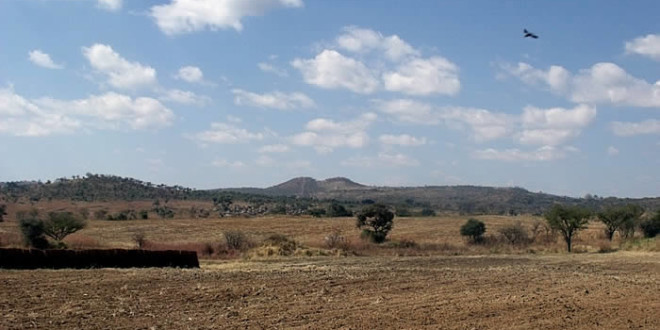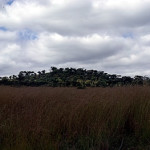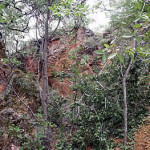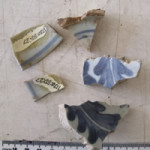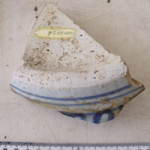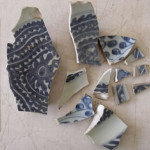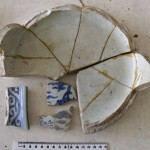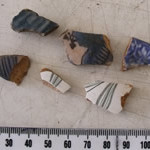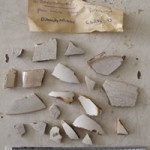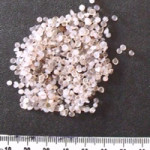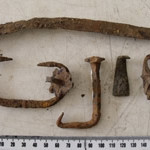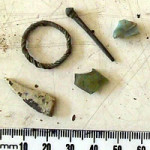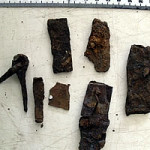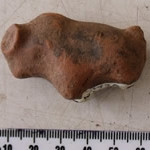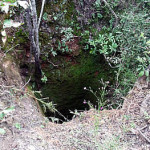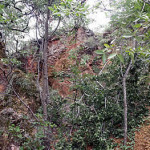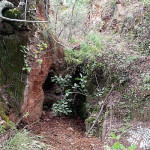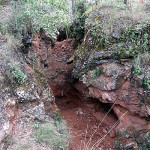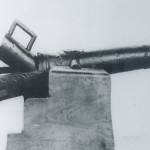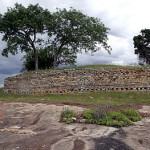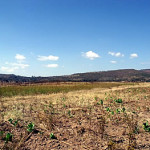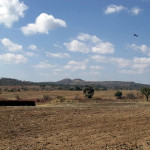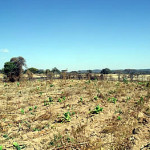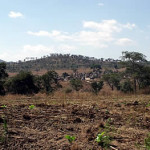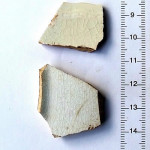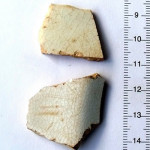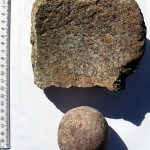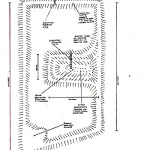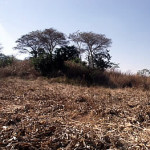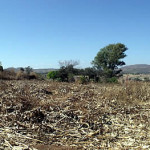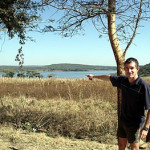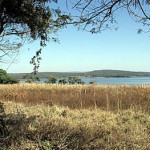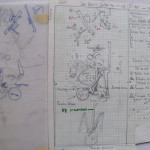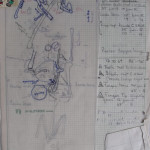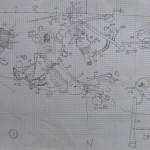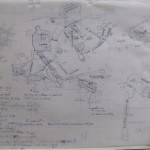Written by Chris Dunbar. All pictures are copyright by Chris Dunbar.
This site is scattered over a very wide area and was a large settlement (Dambarare covers about 6 square km’s), one of the largest Earthworks numbered 2 was flooded when the Jumbo Mine Dam was built, a great shame as while a little excavation work was done the Professor that I spoke with told me that only 2% of the site was studied so truly a great wealth of possible finds lost for ever.
I looked and searched and was very disappointed with the lack of success, I have a few pictures but only one worth anything, it shows a small hill where a very minor earthwork was situated, it was never excavated and all surface remains have gone.
- Site of minor Portuguese earthwork. Dambarare, Zimbabwe. Author and Copyright Chris Dunbar
- Ancient gold workings (near Dambarare, Zimbabwe). Author and Copyright Chris Dunbar
- Dambarare Ceramics. Author and Copyright Chris Dunbar.,
- Dambarare Ceramics. Author and Copyright Chris Dunbar.,
- Dambarare Ceramics. Author and Copyright Chris Dunbar.,
- Dambarare Ceramics. Author and Copyright Chris Dunbar.,
- Dambarare Ceramics. Author and Copyright Chris Dunbar.,
- Dambarare Ceramics. Author and Copyright Chris Dunbar.,
- Dambarare Glass beads. Author and Copyright Chris Dunbar
- Dambarare Metals. Author and Copyright Chris Dunbar.
- Dambarare Metals. Author and Copyright Chris Dunbar.
- Dambarare Metals. Author and Copyright Chris Dunbar.
- Dambarare Native cattle statue. Author and Copyright Chris Dunbar
These pictures are from the “Ancient workings” very near the sites of Dambarare. They were dug before the Portuguese arrived but were a draw card for the Portuguese to settle in the area, I have a lot about Dambarare but was unable to locate any of the actual earthworks despite extensive looking.
- Ancient gold workings (near Dambarare, Zimbabwe). Author and Copyright Chris Dunbar
- Ancient gold workings (near Dambarare, Zimbabwe). Author and Copyright Chris Dunbar
- Ancient gold workings (near Dambarare, Zimbabwe). Author and Copyright Chris Dunbar
- Ancient gold workings (near Dambarare, Zimbabwe). Author and Copyright Chris Dunbar
After the sacking of Dambarare in 1693, it is believed that some of the military loot was moved to the site of Dhlo Dhlo. This was either an attempt to elevate the local king’s status amongst his vassals, or as a trade bargaining chip by the sacker of Dambarare. The canons when found showed that they could not have been fired, after they were removed from Dambarare. They are currently outside the presidential residence in South Africa.
- Portuguese canon found at Dhlo Dhlo Ruins. Dhlo Dhlo, Zimbabwe. Author and Copyright Chris Dunbar
- Dhlo Dhlo Ruins terrace where the canon were found, Dhlo Dhlo, Zimbabwe. Author and Copyright Chris Dunbar
DAMBARARE EARTHWORKS
DAMBARARE EARTHWORK 1:
This is where Professor Garlake focused his excavation efforts. Amazing to think that under here are up to 1000 Portuguese men and women, soldiers and priests buried awaiting discovery.
- 9 Location of Earthwork 1, Dambarare, Zimbabwe. Author and Copyright Chris Dunbar
- 22 Location of Earthwork 1 in the distance. Dambarare, Zimbabwe. Author and Copyright Chris Dunbar
- 11 Inside Earthwork 1, Dambarare, Zimbabwe. Author and Copyright Chris Dunbar
- 18 Probably the church mound, Dambarare, Zimbabwe. Author and Copyright Chris Dunbar
22 is a picture of the site in general the actual earthwork would have been behind the tree in the centre of the picture and would have covered most of that rise as it was quite large. 540 feet x 270 feet.
9, 11 are general shoots from within the fort / earthwork surrounds.
18 is where I locate the church mound seen on figure 2a.
Figure 2a is the shape the earthwork would have taken
32 and 33 are front and back pottery shards found on the surface inside the Earthwork 1.
31 is a guyo grinding stone for crushing gold bearing ore found at the site.
- 33 Surface collections Earthwork 1 front. Author and Copyright Chris Dunbar
- 32 Surface collections Earthwork 1 back. Author and Copyright Chris Dunbar
- 31 Guyo collected from Dambarare. Author and Copyright Chris Dunbar
- Figure 2a Earthwork 1, Dambarare, Zimbabwe. Author and Copyright Chris Dunbar
DAMBARARE EARTHWORK 3:
No visable surface remains but this site was on the edge of this hill overlooking the valley. Earthwork 4, 2 and 1 would have been visable from this earthwork. In my opinion Earhwork 5 would have been too far away to have been visable.
-
Location of Earthwork 3, Dambarare, Zimbabwe. Author and Copyright Chris Dunbar
-
Location of Earthwork 3, Dambarare, Zimbabwe. Author and Copyright Chris Dunbar
- Location of Earthwork 3, Dambarare, Zimbabwe. Author and Copyright Chris Dunbar
- Location of Earthwork 3, Dambarare, Zimbabwe. Author and Copyright Chris Dunbar
DAMBARARE EARTHWORK 4:
When Jumbo Mine Dam was made in the 90’s it flooded Earthwork 4. The best of the feiras, it still had the walls etc, but now consigned to history.
- Location of Earthwork 4, Dambarare, Zimbabwe. Author and Copyright Chris Dunbar
- Jumbo Mine Dam, Dambarare, Zimbabwe. Author and Copyright Chris Dunbar
DAMBARARE, ZIMBABWE: CHURCH GRAVES SKETCHES
Sketches by P. S. Garlake. Historical Monuments Commission, Salisbury.
- Dambarare Church Grave sketches 2
- Dambarare Church Grave sketches 3
- Dambarare Church Grave sketches 1
- Dambarare Church Grave sketches
BIBLIOGRAPHY:
– Various Authors “Documentos sobre os portugueses em Moçambique e na Africa central, 1497-1840. Documents on the Portuguese in Mozambique and Central Africa, 1497-1840” National Archives of Rhodesia and Nyasaland, Centro de Estudos Históricos Ultramarinos, 1962-(1989), Lisboa. Includes indexes. “The sources have been drawn from archives and libraries in Portugal, Italy, France and other countries … Published in the original with an English translation. Contents: v. 1. 1497-1506.–v. 2. 1507-1510.–v. 3. 1511-1514.–v. 4. 1515-1516.–v. 5. 1517-1518.–v. 6. 1519-1537.–v. 7. 1540-1560.–v. 8. 1561-1588.–v. 9. 1589-1615.
– Axelson, Eric “Portuguese settlement in the interior of South-East Africa in the seventeenth century” 17, [1] p. ; Sep. Actas Congresso Internacional História dos Descobrimentos, 5, 1961, Lisboa.
– Axelson, Eric “Portuguese in South-East Africa, 1488-1600” 276 pp. Struik, 1973, Cape Town, S.A.
– Axelson, Eric “Portuguese in South-East Africa, 1600-1700” x + 226 pp. Witwatersrand University Press, 1969, Johannesburg, S.A.
– Ferreira, A. Rita “African kingdoms and alien settlements in Central Mozambique (c. 15th-17th Cent.)” 172 pp. Departamento de antropologia, Universidade de Coimbra, 1999, Coimbra, Portugal.
– Garlake, P. S. “Seventeenth century Portuguese earthworks in Rhodesia” In: “South African Arch. Bull.” n° 84, 1966, pp. 157-170
– Newitt, M.D.D. “Portuguese settlement on the Zambese: Exploration, Land Tenure & Colonial Rule in East Africa” 434 pp. Maps, illus.& plates. Longmans, 1973, London, UK.
– Newitt, Malyn D.D. “A History of Mozambique” 679 pp. maps Hurst and Company, 1995, London, UK.
– Newitt, M.D.D. “The Portuguese on the Zambesi from the Seventeenth to the Nineteenth Centuries” In: “An expanding world” vol. n° 25 “Settlement patterns in early modern colonization, 16th-18th centuries” pp. 279-300 Ashgate Variorum, 1998 In: Race IX, n° 4, pp. 477-498 Institute of Race Relations, 1968, London,
– Newitt, M.D.D. “The Portuguese on the Zambesi: an historical interpretation of the Prazo system” In: “An Expanding World” Vol. n° 4; Disney, A. “Historiorgraphy of Europeans in Africa and Asia 1450-1800” Ashgate Variorum, vol. n° 4, 1995; pp. 155-173 Also in: “Journal of African History” vol.10, n°1, 1969, Cambridge, pp. 67-85
– Rea Francis, W. “The economics of the Zambezi missions, 1580-1759” 189 pp. Institutum Historicum S. I., 1976, Roma, Italia.
– Strandes, J. “The Portuguese period in East Africa” xii, 325 pp., 5 plates, folding map, Edited by J. S. Kirkman, 1968, Nairobi, Kenya.
 Colonial Voyage The website dedicated to the Colonial History
Colonial Voyage The website dedicated to the Colonial History
